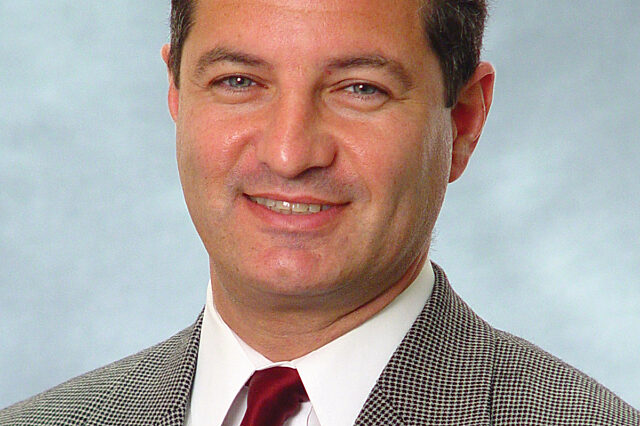UF research snuffs out notion that smokeless tobacco is lesser of two evils

Scott Tomar, D.M.D., Dr.P.H., department chairman and a professor of community dentistry and behavioral science at UF's College of Dentistry
Millions of Americans make the New Year's resolution to stop smoking, but far too many break ranks before Jan. 2. Their dismal success rate has health officials scrambling to come up with easier ways to quit, and many have toyed with the idea that smokeless tobacco could ease the transition off cigarettes. But research by University of Florida scientists suggests that tactic would be a catch - 22, especially in younger smokers.
More than 40 million Americans smoke, according to the Centers for Disease Control and Prevention, and about 70 percent of them are trying to kick the habit. The CDC estimates that the long-term health problems associated with smoking - particularly lung cancer, chronic lung disease and heart disease - result in 438,000 deaths every year. Public health officials are unanimous in the belief that something must be done. But what?
"There have been a number of papers saying that the health community should tell the public that smokeless tobacco is 'safer' than smoking - but not 'safe' per se," said Scott Tomar, D.M.D., Dr.P.H., department chairman and a professor of community dentistry and behavioral science at UF's College of Dentistry.
That theory, called "tobacco harm reduction," aims to wean smokers off cigarettes by advising them to switch to smokeless products, such as snuff and chewing tobacco. Tomar's research suggests that few smokers seem interested in making this switch and he worries that promoting smokeless tobacco could encourage nonsmokers to pick up a dangerous and addictive habit.
"I don't think there's any doubt among members of the scientific community that smokeless tobacco carries a lower risk of death than does cigarette smoking," Tomar said. "On the other hand, that alone doesn't necessarily make it an appropriate recommendation coming from the health community."
Smokeless tobacco products contain almost 30 ingredients known to cause cancer. A recent study by the International Agency for Research on Cancer linked smokeless tobacco to cancers of the mouth and pancreas, as well as oral problems such as recessed gums and bone loss.
Nonetheless, supporters of the tactic insist that smokers might show a greater interest in switching to smokeless tobacco if they were made aware of the reduced health risks.
"There have been claims by proponents of smokeless tobacco that the public can't separate the risks of smoking from the risks of other types of tobacco use," Tomar said.
Younger smokers are especially worrisome. Experts warn that lighting up at a young age can set the stage for a lifetime of dependence. More than 80 percent of older smokers lit up for the first time before they turned 18, according to the CDC. And every day, about 3,900 youth are doing just that.
To find out if younger smokers could differentiate between health risks associated with various tobacco products, Tomar analyzed data from more than 11,000 high school seniors over a five-year period. The data were collected through the Monitoring the Future project conducted by the University of Michigan's Institute for Social Research.
Tomar's study, which was published in the November issue of Nicotine & Tobacco Research, revealed that high school seniors who smoke greatly underestimate the risks associated with their tobacco use. Fewer than half of those interviewed perceived a great risk of harm from cigarettes. In contrast, more than 80 percent of nonsmokers regarded smoking as hazardous to their health.
"Very few smokers in 12th grade perceive that what they're doing is harmful," Tomar said. "That's really what makes this whole idea so challenging. Advocates are saying you should tell these young smokers, 'We're not saying smokeless tobacco is safe, but it's safer than cigarettes.' But you're telling that to a population who already tremendously underestimates their own risk."
But would the advice work?
"We've seen almost no smokers moving toward smokeless tobacco. If anything, it tends to be in the other direction," Tomar said. "We've done previous studies of 17-year-olds who were only using smokeless tobacco. Four years later, 40 percent of them had either added cigarettes to the use of smokeless tobacco or completely switched to smoking. We saw almost no movement in the other direction."
Many experts agree that the marketing strategy could do more harm than good.
"There is concern that a major advertising campaign of smokeless tobacco as less harmful than cigarettes may threaten the major reduction in adolescent initiation that we have seen in recent years," said John Pierce, Ph.D., the Sam M. Walton professor for cancer research at the University of California at San Diego Cancer Center.
"There is plenty of evidence that advertising influences younger people."
Tomar's findings suggest that advertising money might be better spent on educating younger smokers about the hazards of tobacco use.
"People will only take steps to change if they perceive that their current behavior is harmful," Tomar said. "With young people, what they're reporting is that they don't think they're at risk for harm. Why would they want to switch to something that's less harmful?"